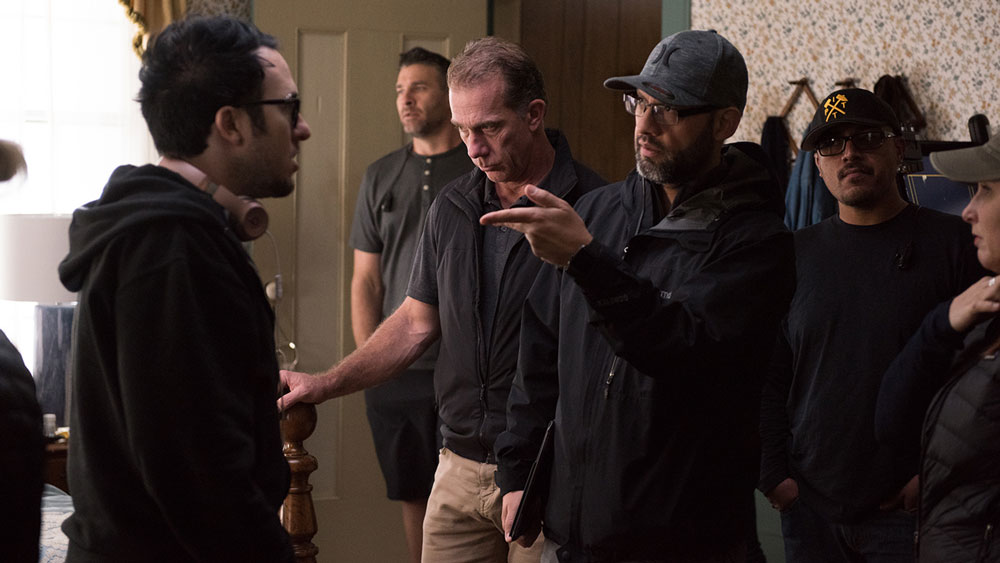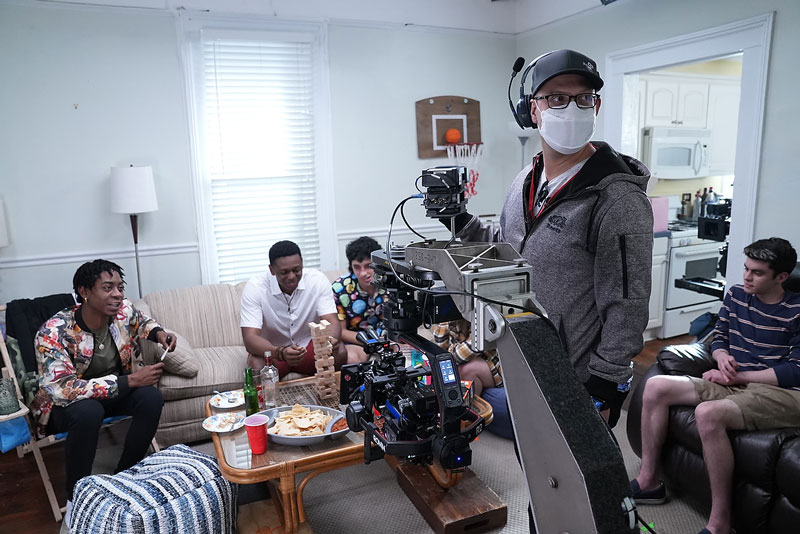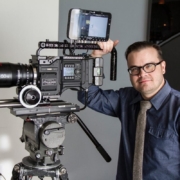Finding the Frame: Michael Dallatorre
Michael Dallatorre worked his way up from prepping cameras at Panavision to lensing films like Brightburn, Studio 666, and the Amazon Prime Original film Emergency. Filmmakers Academy’s Brendan Sweeney sat down with Dallatorre to discuss his career from starting out in the prep room to his approach to lensing feature films.
Watch the full interview!
MICHAEL DALLATORRE
Michael Dallatorre was born in Nicaragua and moved to South Central Los Angeles at the age of three. Dallatorre and his family moved through different neighborhoods of South Central, like Inglewood and Compton.
In high school, Dallatorre was very active in extracurricular programs from football and track to student government. He also took part in the theater program and was featured in the signature production, Watts Side Story. A non-profit performing arts group called Colors United captured the making of the production in the documentary, Colors Straight Up, which was nominated for an Academy Award. Not only did Micheal act but he lent a hand to the production, moving equipment, interacted with the camera crew, and met Theo van de Sande, ASC.
When his friend, Sal Alvarez, PAed on Justin Lin’s UCLA thesis film, Shopping for Fangs, he invited Dallatorre to tag along. Every weekend, Dallatorre began taking the bus all over Los Angeles to work on thesis films for USC and AFI students. Increasingly exposed to the filmmaking process, he was drawn to the camera department.
PANAVISION
After graduating high school, Dallatorre joined a summer program called Inner-City Filmmakers. The filmmaking program granted aspiring filmmakers access to Kodak and Paramount. It was soon after that Dallatorre attended Los Angeles City College. However, while in school, Dallatorre took a job at Panavision and discovered he was getting much more of an education through real-life applications.
While continuing to work on student films, Dallatorre found himself often traveling from Compton to Woodland Hills to prep at Panavision. He made friends with the Panavision personnel and one day asked, “How do you get a job here?” The answer was simple – “Just ask Darlene in the back. She’ll give you an application.” A month later, Panavision called Dallatorre back for an interview and hired him.
Work became so busy at Panavision that Dallatorre had to make a decision: Panavision or school. He learned so much at Panavision and made so many crucial contacts with camera assistants that the decision was simple. He chose Panavision and was invited to sets nearly every weekend by camera assistants looking for help. “The amazing thing that Panavision gave me was that they let me use their equipment,” recalls Dallatorre. “That blew my mind.” He worked in the shipping department and when he requested a Panaflex with super speeds. The response was a simple, “Sure.”
Much like Michael Dallatorre, Filmmakers Academy mentor Derek Edwards started his filmmaking career at Panavision. Schedule a mentorship today!
Dallatorre met plenty of loaders who had thousands of feet of short ends. So, between Dallatorre and other Panavision workers, they would take the short ends and practice shooting film over the weekend. Most of the Panavision higher-ups began their careers in the shipping department, like Phil Raiden, Bob Harvey, Jim Roudebush, and David Dodson.
After starting in shipping, Dallatorre moved up to the prep floor within a year and worked as a prep tech for nine years. He graduated to lead prep tech where he toiled for over four years before transitioning to the marketing department where he ran the new filmmaking program. Altogether, Dallatorre worked at Panavision until 2019, amounting to 18 years.
CONNECTING WITH HARD-WORKING FILMMAKERS
It was while working at Panavision, Dallatorre met future collaborators. He met the director of Emergency, Carey Williams, all the way back in 2003 when he saw a music video Dallatorre shot and really liked it. Williams contacted the band and got Dallatorre’s information and they started working together and subsequently became friends.
They loved each other’s visual style but most of all they both worked hard.
“I want people that I work with to work as hard as I do,” says Dallatorre. “So, if you’re lazy, I don’t want to work with you.”
Sure, they made mistakes but they were learning, meeting people, and growing as filmmakers. In a similar vein, Dallatorre met David Yarovesky, the future director of Brightburn, around 2007. This relationship would change the trajectory of his cinematography career.
THE PATH OF A CINEMATOGRAPHER
Dallatorre realized he was on the right path as a cinematographer when he landed a Doublemint commercial featuring Chris Brown. It was a project where everything seemed to click. The commercial was shot on green screen and the filmmakers used animatics to determine how they would shoot it. The product was a digital pack of gum that Brown would interact with while one of his songs played.
FILMING BRIGHTBURN
However, his career really took off with Brightburn. By that time, it was his fourth feature but his previous films were all under half a million dollars. Brightburn, by comparison, had a $6 million budget with James Gunn supporting them. On top of that, the premise was really interesting as it turned the Superman origin story on its head.
“That was one of those moments where I really was like, okay, I need to not only continue what I’m doing but also I need to up my game because I’m stepping into a whole other league.”
Dallatorre had previously worked on short films with Yarovesky, so when he booked Brightburn, he asked the DP if he was interested. After reading the script, Dallatorre knew it would be a challenge but was more than ready for the opportunity. Before going into a film, Dallatorre has a “date night” with his directors where he orders a few pizzas and watches some movies that relate to their project.
CAMERAS AND LENSES
They shot the film on the Arri Alexa Mini and the Alexa XT Plus and used the Panavision T-Series Anamorphic Lenses. Dallatorre loves the sharpness of the T-Series. Most anamorphic lenses tend to have the same nice fall off but the whole image isn’t sharp. Then, that creates a lot of work in VFX. The lenses also feel “poppier” to Dallatorre, “kind of like a comic book.” He likens it to a comic book frame where there’s a blurry background while the character is sharp and in focus. Dallatorre also loves the color rendition of the T-Series and how it handles flares.
Dallatorre shot some blind tests before landing on the cameras and lenses. “Basically, I will shoot a test with different cameras,” says Dallatorre, “but not put on the slate what the cameras or lenses are. So, [directors] can’t have a preconceived conception.” That way, rather than choose their lenses based on a movie they liked, Dallatorre allows them to look at the tests and choose for themselves what that particular project looks like.
VFX
Dallatorre had lots of experience shooting music videos on green screens, so he understood keying and blue versus green. They had the help of the VFX studio Trixter along with a VFX producer and VFX supervisor. And according to Dallatorre, watching them work became a masterclass in VFX.
For the scene where Tori Breyer (Elizabeth Banks) hides under the table and Brandon (Jackson Dunn) flies through the house three times, that was actually seven shots. The VFX team determined where to put Banks and then took her out to film the practical side of the scene. This entailed three cannons that shot projectiles through the frames. Then, they shot plates and put blue where the kitchen lights were to make them swing and blue where Banks was positioned.
“I started to learn blue screen versus green on some of those because the green light reflects a lot,” recollects Dallatorre. “And it almost acts – not necessarily like a white card – but it’s got more luminance than the blue. And the blue would almost work as a negative fill.”
They ended up using more blue because of the film’s contrast.
FILMING STUDIO 666
Studio 666 is a horror comedy band movie that features the Foo Fighters. It’s like an 80s slasher throwback full of practical effects and gore. Anyone who knows Dave Grohl knows that he does everything at 110% and according to Dallatorre, you want to reciprocate that work ethic. When Dallatorre met the film’s director, BJ McDonnell, who had a clear vision for the film.
Since it wasn’t a studio film, there wasn’t anyone who they had to check in with. They also had talented veterans working with them like Tony Gardner, who did the makeup effects for such films as 127 Hours, Zombieland Double Tap, and Hocus Pocus 2.
The filmmakers got to work fast. They only had two weeks of prep so McDonnell gave Dallatorre a lot of latitude to make decisions. He chose the Alexa Minis and Panavision Zeiss super speeds – his go-to setup. His colorist was Mitch Paulson at Company3 who he has worked with on four projects. They used a film emulation LUT that looks like 5219. Dallatorre has used the LUT on everything from Brightburn to Emergency.
Filmmakers Academy interviewed the producers of Studio 666. Learn more about how the filmmakers pulled off the crazy practical effects!
FILMING EMERGENCY
Emergency captures situational humor while also creating a social discourse. The film’s director, Carey Williams, took part in a Film Independent program called Project Involve. It’s an amazing program that chooses five directors, five cinematographers, five writers, five editors, and five producers to mentor. Carey was part of the program and first hatched the idea for the project which was then created as a short film. The film went on to win awards and built up enough steam for the feature film adaptation we now know as Emergency.
Williams is very visual and purposeful with his framing. Together, Dallatorre developed his language with Carrie and as they progressed through prep, saw the locations in Atlanta, and developed the visuals. One of the things that Dallatorre does when he breaks down a script is highlight the emotional beats. For instance, if there was a disconnect between two characters, Dallatorre would use different lenses to help convey it.
Dallatorre used his horror background in depicting the police – or lack thereof. Rather than show the faces of police officers, he pitched to Williams to never see them. Instead, they show aspects of the police so they feel like a force that looms over the protagonists.
The colors were very intentional. For instance, the party that Sean (RJ Cyler) goes to at the end is red because that’s the color of the emergency room sign light hitting him. In Atlanta, the police emergency lights are blue, so Dallatorre petitioned to make theirs red and blue. That way, between the white of the hospital to the red and blue, it articulates the colors of the American flag.
Cameras & Lenses
They used the Alexa Mini LFs with the large format Panaspeed lenses because most of the movie takes place in a van. They shot the majority of the van on an LED stage, so all of the interiors are LED. Williams wanted to feel the intimacy of the characters. They used a longer lens with a wider field of view.
They chose the 35s in the van which have the same field of view as a 21, but provided a more rectilinear image so it didn’t feel as distorted. Instead, you felt like you were in the van with them. “Then because the lenses let you get close focus so well,” explains Dallatorre, “we could be in the van 20 inches away from someone and focus and it would not look weird.”
ADVICE FOR FILMMAKERS
Michael Dallatorre’s advice to up-and-coming filmmakers is to be passionate about what you want to do. He feels very blessed and grateful to be able to live his dream as a cinematographer. According to Dallatorre, you must have a vision. Every project he has takes something from him. Working on films takes time from not only your life but time spent with loved ones.
The key to when you’re starting is to try and find the people like you. If you work hard and they work hard, that is someone you will want to work with. Build the community of filmmakers that you want to work alongside. “Shoot as much as you can,” says Dallatorre, “and really, really study.”
In the past, Dallatorre didn’t have resources like Filmmakers Academy to show him how to film something to look a certain way. Filmmakers today can easily access courses and mentors to learn exactly how to achieve the image they’re after.
“You have people like Shane [Hurlbut, ASC],” continues Dallatorre, “who shows you everything you need to know along the way.”
Dallatorre didn’t feel like a true cinematographer until three years ago when he left Panavision and joined the union. Now that he has an agent and shot feature films, he no longer feels like the Panavision guy who shot stuff. At 43 years old, Dallatorre puts it bluntly, “it takes time, it takes a lot of work, stuff isn’t going to go right a lot of the time, and you’re going to run into pitfalls… you just got to keep going.”
It’s a lot of hard work getting there but when Dallatorre gets to see his work on the big screen and the effect it has on the audience, “it’s just everything.”
FOLLOW MICHAEL DALLATORRE
Michael Dallatorre has a few projects in the works, including a TV show produced by Ava DuVernay called Cherish the Day.
For more, follow Michael Dallatorre on Instagram at DP_MikeD.
















